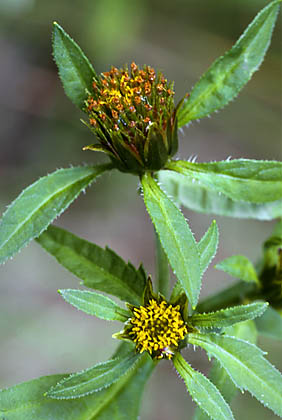Flowerers still found
Photo: Arne Ader
Translation: Liis
Trfid-bur marigold
Trifid-bur marigold Kolmisruse Bidens tripartita
A common plant in moist habitats: can be found at the banks of water bodies and road ditches and other somewhat muddy locations. People have once called it porilill, "mud flower“.
The trifid-bur marigold leaves an impression of yellowish-green. Upper leaves under the capitula (flowerhead) are entire, the lower have three to five lobes the tip one of which is dissected. The leaves are sometimes glossy.
The small yellow flowers are in a capitula (composite inflorescence); they are a centimetre in diameter – as long as they are wide. Most inflorescences consist of disk florets, rarely a ray floret among them. The disk florets contain both pistils and stamens, the ray florets only pistils.
The trifid-bur marigolds set fruit in late autumn and their seeds are similar to those of sunflowers – dark brown in colour and glossy. At the tip of the seeds there are three bristles and on them tiny barbs, which hook on to bypassers in order to reach new possible habitats.
A plant well worth closer study.









